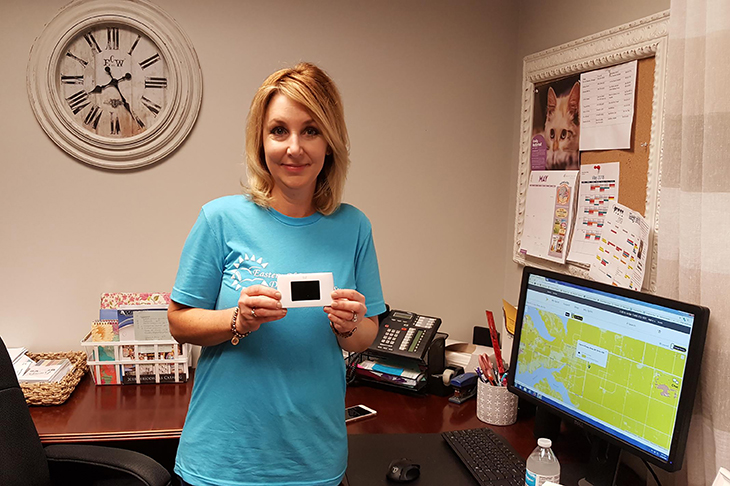
OSU, public libraries working together to bridge ‘digital divide’ in rural Oklahoma
Wednesday, June 6, 2018
Oklahoma State University’s Division of Agricultural Sciences and Natural Resources is expanding its cooperating partnership with select public libraries to enhance broadband access to residents in some of the state’s more rural areas.
Four new public libraries are teaming up with OSU this year: The Grove Public Library, the Guthrie Public Library, the Okemah Public Library and the Sayre Public Library. The program is offered through the Oklahoma Cooperative Extension Service, one of two state agencies administered by DASNR.
“We’re very pleased to be working with OSU as most people in our area do not have broadband access,” said Sue Warnke, head librarian of the Sayre Public Library. “Just about every night there are cars parked around the library with drivers and passengers tapping into our wifi network. That’s fine but this program makes broadband access much more convenient and allows people to probably get more done.”
The DASNR program essentially “loans out the internet” by allowing individuals to check out one of four mobile hotspot devices assigned to the library.
“These devices use cellular networks, the same as smartphones,” said Brian Whitacre, OSU Cooperative Extension agricultural economist and the program’s principal investigator. “They can be used inside a home; taken to restaurants, community centers and the like; and even go on a road trip. As long as the cellular network provider used by the hotspot has service in that area, the devices will provide broadband access.”
The mobile hotspot technology can be used to hook up multiple devices. Individual libraries have specific policies about who can check out the hotspot devices and the length of the loan period. Generally speaking, most libraries with such a program allow adults with a valid library card to check out the devices for a period of one week.
“Many Okfuskee County residents do not have wifi and we have only six public computers at the library, so we saw the OSU program as a great opportunity to provide needed digital services,” said Teresa Labbe, head librarian at the Okemah Public Library. “Our hope is that it assists people with job training, job searches, students doing web-based homework and just social connections in general, promoting a greater sense of community.”
Brenda Newnam, branch manager of the Grove Public Library, agreed, adding the library was not only “excited to be working with OSU Cooperative Extension as [they] were aware of the success of last year's pilot program” but saw the mobile hotspots as a way to strengthen their own electronic offerings.
“Brian talks about how OSU Cooperative Extension strives to improve the quality of life for state residents, and we do that in our own way as well by making available e-books, downloadable audio files, self-help and certification programs, movie streaming and so much more,” she said.
Last year, DASNR joined forces with the Elgin Community Library, the Reiger Memorial Library in Haskell, the Thomas-Wilhite Memorial Library in Perkins and the Seminole Public Library to showcase how broadband access can make a positive difference in people's lives. DASNR and its cooperating partners not only asked local residents to take advantage of the pilot program but also to provide feedback as to their experiences.
“The response to last year’s pilot program was overwhelmingly positive,” Whitacre said. “More than 90 percent of respondents gave the program an average score of better than nine out of 10.”
Whitacre added there were many favorable comments about the mobile hotspots making it easier for parents to help their children with homework, playing an instrumental role in the start-up of small businesses, assisting in the planning of community events and keeping people in touch with family members residing within or outside their hometowns.
“A number of respondents even called the mobile hotspots ‘a blessing,’” he said. “Basically, this program has proven to be extremely beneficial for those using it. Our hope is to continue expanding the program into new communities each year.”
It is no secret that life in the 21st century has increasingly become interdependent with internet access, yet the cost of maintaining a monthly connection exceeds what far-too-many Oklahomans can afford.
A 2015 survey indicated that only 44 percent of Oklahoma households with incomes of less than $25,000 have a broadband connection. This is less than half of the 91 percent for Oklahoma households with incomes greater than $100,000.
“It’s very easy for individuals who have broadband access to take it for granted,” Whitacre said. “Think about all you do through the internet. Many people living in rural areas are not able to do those taken-for-granted activities as easily. DASNR’s mobile hotspots program is one way OSU is meeting its land-grant mission to help Oklahomans improve the quality of life for themselves, their families and their communities.”
Anyone interested in additional information about either the library mobile hotspots program or potential ways to enhance broadband access to rural Oklahoma should contact Whitacre by email at brian.whitacre@okstate.edu or by phone at 405-744-9825.
